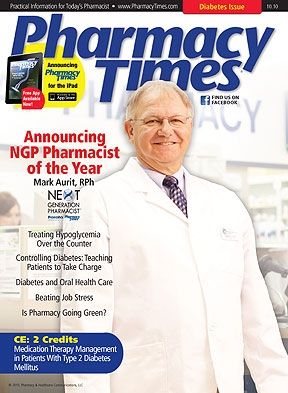Publication
Article
Pharmacy Times
Specialty Pipeline for the Treatment of Type 2 Diabetes Mellitus
Newer pharmaceutical agents for the treatment of type 2 diabetes suggest a movement toward diabetes becoming a specialty disease state.
Newer pharmaceutical agents for the treatment of type 2 diabetes suggest a movement toward diabetes becoming a specialty disease state.


Todd Cooperman, PharmD, RPh, PAHM Russel Allinson, RPh, MS
Traditionally, diabetes has not been thought of as a specialty pharmaceutical disease state, with therapy being dominated by small molecular products such as glyburide, metformin, and rosiglitazone, to name but a handful. The physical characteristics and monthly costs misalign significantly with what would be considered a specialty product. Even with the use of insulin products, this disease state has not been considered a specialty disease state, mostly due to the fact that insulin use predates the existence of the term “specialty pharmaceuticals.”
More recently, however, there have been clinical trials of drugs within the diabetes market that would be considered “specialty” products. Most notably, these newer products are members of the glucagon-like peptide-1 (GLP-1; exenatide [Byetta]) and liraglutide [Victoza]) and amylin analog (pramlintide [Symlin]) classes.1-3 The approval of these products represents the initial movement in the diabetes market toward becoming a specialty disease state.
NEWER CLASSES
There are significant products in early development within the diabetes therapy pipeline. These newer classes include the gastric inhibitor peptides, sodiumdependent glucose transporter inhibitors, and fructose 1,6-bisphosphatase inhibitors. The agents within these classes are mostly within phase I and phase II clinical trials, which are outside the scope of this column. In addition, several small molecular agents within the pipeline exist that do not fall into the traditional definition of specialty products. Focusing solely on peptide agents that are currently being investigated within phase III studies reveals 2 agents within the GLP-1 class.4 Taspoglutide is a once-weekly GLP-1 analog being investigated by Hoffman-La Roche. Taspoglutide’s mechanism of action is similar to human GLP-1. GLP-1 functions through the enhancement of glucose-stimulated insulin secretion for beta-cells, inhibiting appetite, inhibiting glucagon secretion, delaying gastric emptying, and promoting pancreatic betacell proliferation.5 The unique quality of taspoglutide, compared with current GLP-1 agents on the market, is that it is administered once weekly due to its resistance to dipeptidyl peptidase-4 cleavage. This results in an average half-life of 9.8 hours, compared with 50 minutes for human GLP-1.6
EFFICACY OF TASPOGLUTIDE
In a study conducted by Nauck et al to determine the efficacy of taspoglutide in patients with type 2 diabetes who had an inadequate response to monotherapy with metformin, the following was reported. After 8 weeks of therapy, patients receiving taspoglutide had significantly lower hemoglobin A1C (A1C) compared with patients receiving placebo. The greatest reduction was observed within patients receiving 10 or 20 mg once weekly. In addition, fasting plasma glucose was significantly reduced after 1 week of therapy. Other beneficial physiologic effects included a mean reduction in triglycerides of 26 to 48 mg/dL, a reduction in total cholesterol of 4 to 13 mg/dL, and a reduction in weight of 2.1 to 2.8 kg.7
Lixisenatide (sanofi-aventis) is a oncedaily synthetic GLP-1 receptor agonist that is currently in phase III clinical trials. The unique characteristic of lixisenatide is its binding affinity to the GLP-1 receptor. Binding studies have shown that lixisenatide binds at 4 times the affinity compared with endogenous human GLP-1. In preclinical studies in rats, lixisenatide was shown to protect beta-cell apoptosis. Within human islet cells, it was found to preserve insulin production, storage, and beta-cell function. Whether these observations translate within clinical studies is still to be determined as human study data are collected.8
In a study by Ratner in patients with type 2 diabetes with inadequate response to metformin, lixisenatide was evaluated for its effect on A1C. Patients receiving lixisenatide had on average an A1C reduction of 7.55% from baseline. The most commonly experienced side effect was nausea and there was no correlation of hypoglycemic events with lixisenatide dose. As with the other GLP-1 agonists, a reduction in weight was observed of 2 to 3.5 kg.9
SUMMARY
There are multiple agents in the pipeline for the treatment of diabetes type 2. A handful are peptide products and only 2 may reach the market in the next few years. Both agents belong to the GLP-1 receptor agonist class. Taspoglutide represents a once-weekly GLP-1 agonist, which may enhance compliance and persistence in patients with diabetes. Its favorable effects on lipid levels and weight may prove to be beneficial for long-term outcomes in patients. Lixisenatide is a oncedaily GLP-1 agonist, which binds at 4 times the affinity of endogenous GLP-1. The long-term relevance of this highbinding affinity is still to be determined. Although these 2 agents do not provide a novel mechanism compared with agents currently on the market, they do provide a natural evolution in the enhancement of current therapy.
Dr. Cooperman is director of research and developmentand Mr. Allinson is chief executive officer and chief clinical officer of Therigy, LLC.
References
1. Product Information: BYETTA(R) subcutaneous injection, exenatide subcutaneous injection. Amylin Pharmaceuticals, Inc., San Diego, CA 2009.
2. Product Information: SYMLIN(R) subcutaneous injection, pramlintide acetate subcutaneous injection. Amylin Pharmaceuticals, Inc, San Diego, CA 2008.
3. Product Information: VICTOZA(R) solution for subcutaneous injection, liraglutide rDNA origin solution for subcutaneous injection. Novo Nordisk, Inc, Princeton, NJ 2010.
4. Akkati S, Sam KG, Tungha G. Emergence of promising therapies in diabetes mellitus. J Clin Pharmacol. Published online before print August 12, 2010, doi: 10.1177/0091270010376972. http://jcp.sagepub.com/content/early/2010/08/12/0091270010376972.abstract.
5. Sebokova E, Benardeau A, Sprecher U, Sewing S, Tobalina L, Migliorini C. Taspoglutide, a novel human once-weekly analogue of glucagon-like peptide-1, improves glucose homeostasis and body weight in the Zucker diabetic fatty rat. Diabetes, Obesity and Metabolism. 2010;12(8):674-682.
6. Sebokova E, Christ AD, et al. T. Taspoglutide, an analog of human glucagon-like peptide-1 with enhanced stability and in vivo potency. Endocrinology. 2010 Jun;151(6):2474-2482.
7. Nauck MA, Ratner RE, Kapitza C, Berria R, Boldrin M, Balena R. Treatment with the human once-weekly glucagon-like peptide-1 analog taspoglutide in combination with metformin improves glycemic control and lowers body weight in patients with type 2 diabetes inadequately controlled with metformin alone. Diabetes Care. 2009; 32(7):1237—1243.
8. Werner U, Haschke G, Herling AW, Kramer W. Pharmacological profile of lixisenatide: A new GLP-1 receptor agonist for the treatment of type 2 diabetes. Regul Pept. 2010;164(2-3): 58-64.
9. Ratner RE, Rosenstock J, Boka G. Dose-dependent effects of the once-daily GLP-1 receptor agonist lixisenatide in patients with type 2 diabetes inadequately controlled with metformin: a randomized, double-blind, placebo-controlled trial. Diabet Med. 2010;27(9):1024-1032.







